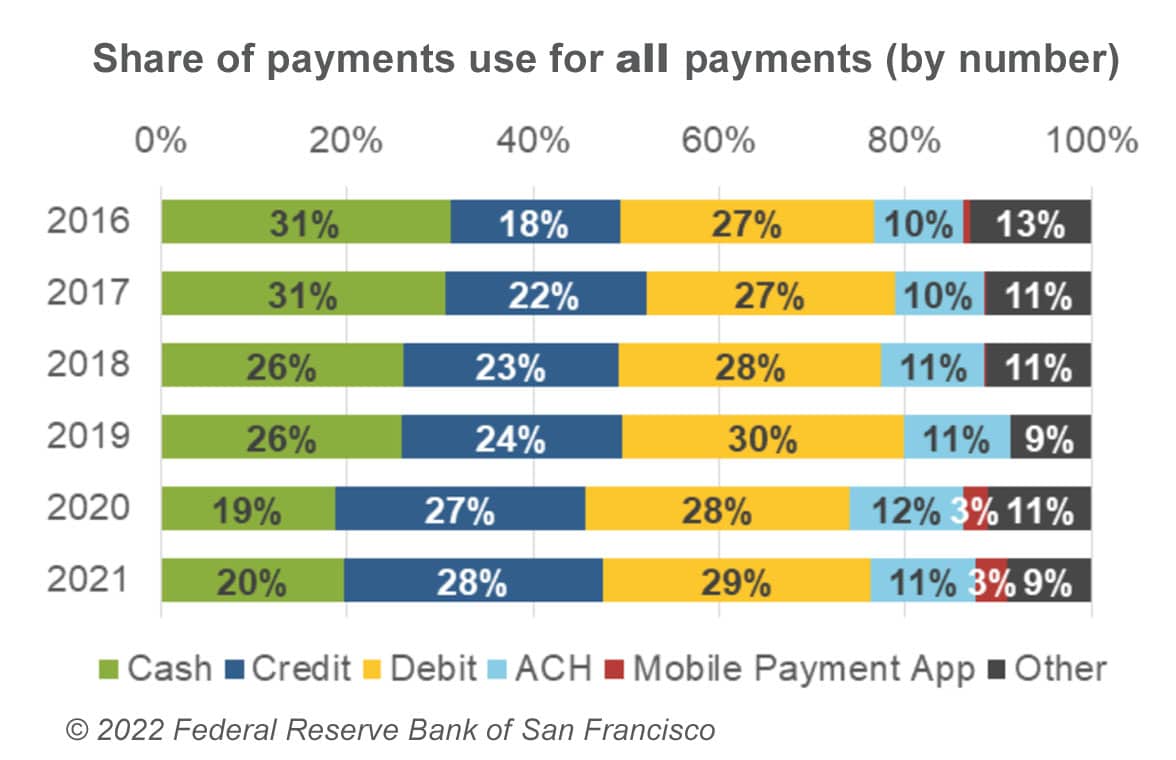
The total number of payments in the USA made using cash fell from just over one in four in 2019 (26%) to under one in five in 2020 (19%) before increasing slightly to 20% in 2021, the Federal Reserve reports.
The Reserve’s 2021 Diary of Consumer Payment Choice also reveals “a statistically significant decline” in the number of consumers who cited cash as their preferred payment method for in-person transactions from 23% in 2019 to 19% in 2021, an overall decrease of eight percentage points from 27% in 2016.
At the same time, the proportion of payments made using a credit or debit card increased from 54% in 2019 to 55% in 2020 and 57% in 2021, with the percentage of consumers citing credit and debit cards as their preferred payment method reaching 32% and 44%, respectively, in 2021.
“Consumers reduced their shares of cash use across all ages by a statistically significant amount compared with 2019,” the researchers say.
“Consumers younger than 45 used cash for less than 20% of payments; older consumers used cash for more than 20%.”
The Reserve also found, however, that cash use remained higher in lower income households, saying that “in 2021, the share of cash use for consumers in households making less than US$25,000 was approximately three times higher (36%) than that of those living in households making more than US$150,000 (11%).”
Payment behaviour
According to the report, the overall decrease in cash use in the USA during the pandemic is due to the following factors:
- Consumers shopped less in person resulting in a lower share of in-person payments overall and fewer opportunities to use cash in 2020 and 2021 compared with 2019.
- Fewer consumers reported a preference for using cash when making payments in person, reducing cash use for in-person purchases and peer-to-peer (P2P) payments.
- Use of P2P payment apps increased which caused fewer hand-to-hand P2P payments.
- The change in everyday shopping habits resulted in fewer small-value payments of less than $25 in 2020 and 2021 compared to 2019.
“The findings of the 2021 Diary reflect the continued impact of the pandemic on consumer payment behaviour,” the researchers add.
“While total payments, cash payments, and the number of in-person payments in 2021 all increased compared with 2020, these increases were not statistically significant.
“A key finding from this year’s study is that cash use decreased, and credit card use increased for consumers across all household income levels throughout the pandemic.
“The one exception was for consumers with household incomes of less than $25,000, whose cash use has been consistent leading up to and throughout the pandemic. These consumers make up nearly 20% of the US population, so a significant portion of the US adult population remains dependent on cash for everyday payments.”
The findings in the 2021 Diary are based on a survey of participants who reported all their payments made over a three-day period, the value of their cash holdings, payment instruments they have adopted and their preferences for various types of payments in October 2021.
A survey by a division of WSFS Bank found that two-fifths of US consumers still cited cash as their preferred payment method in September 2021.
Next: Visit the NFCW Expo to find new suppliers and solutions